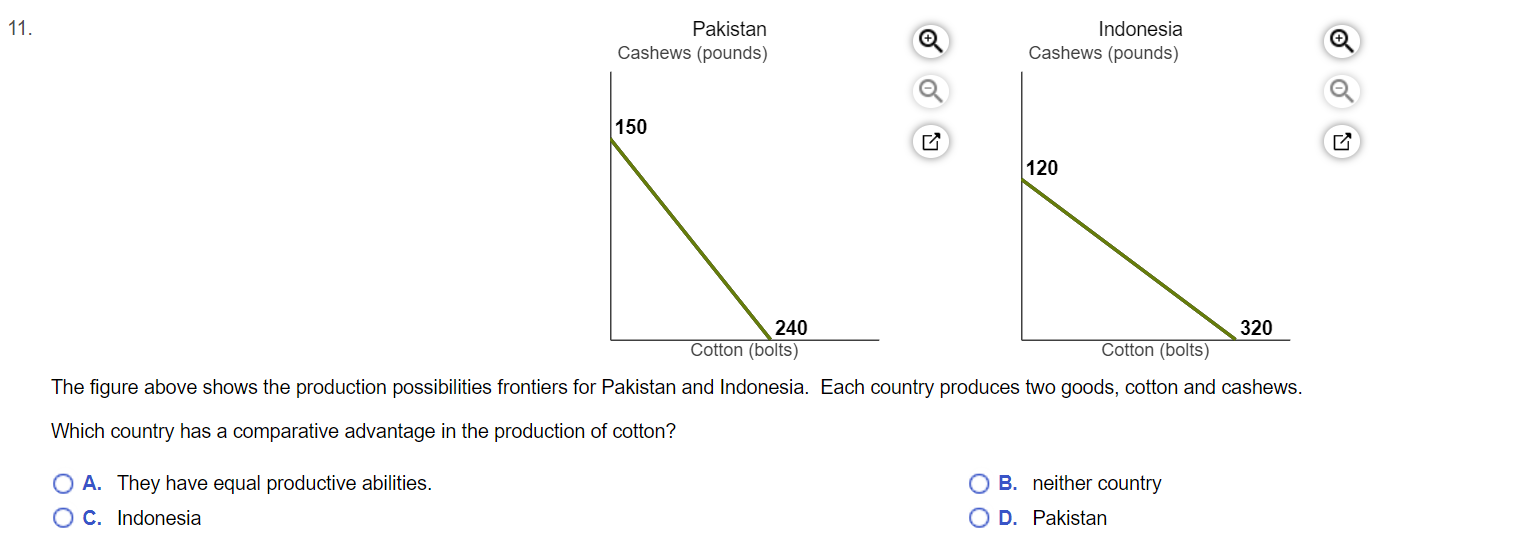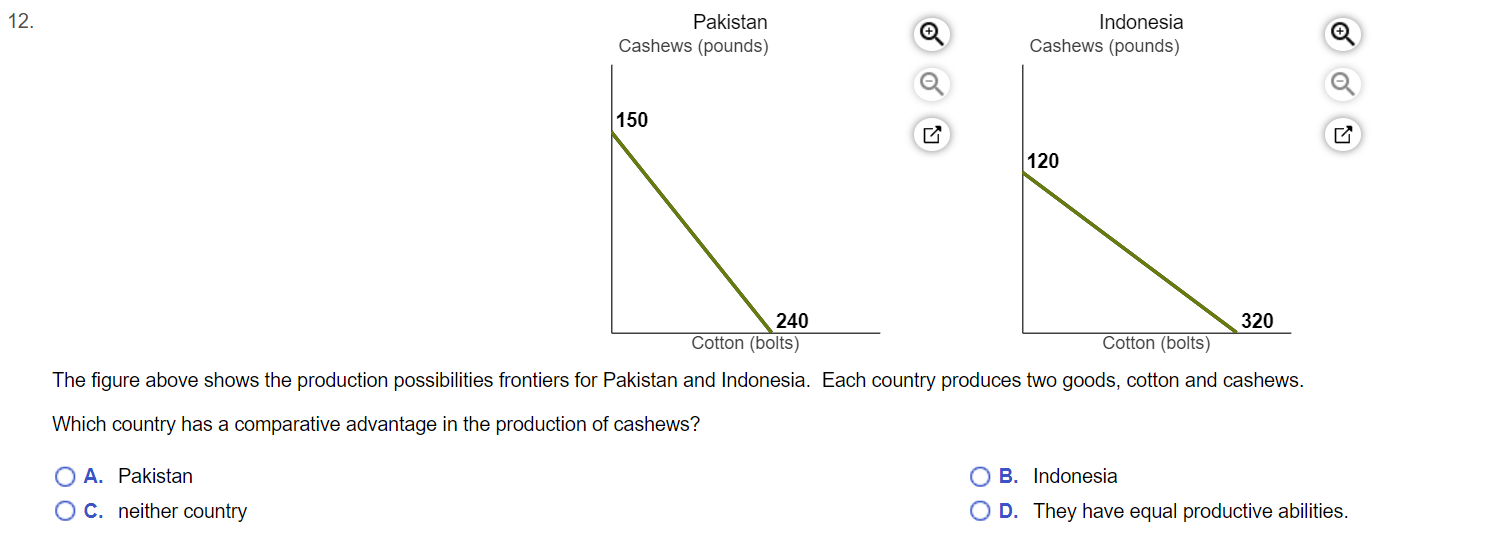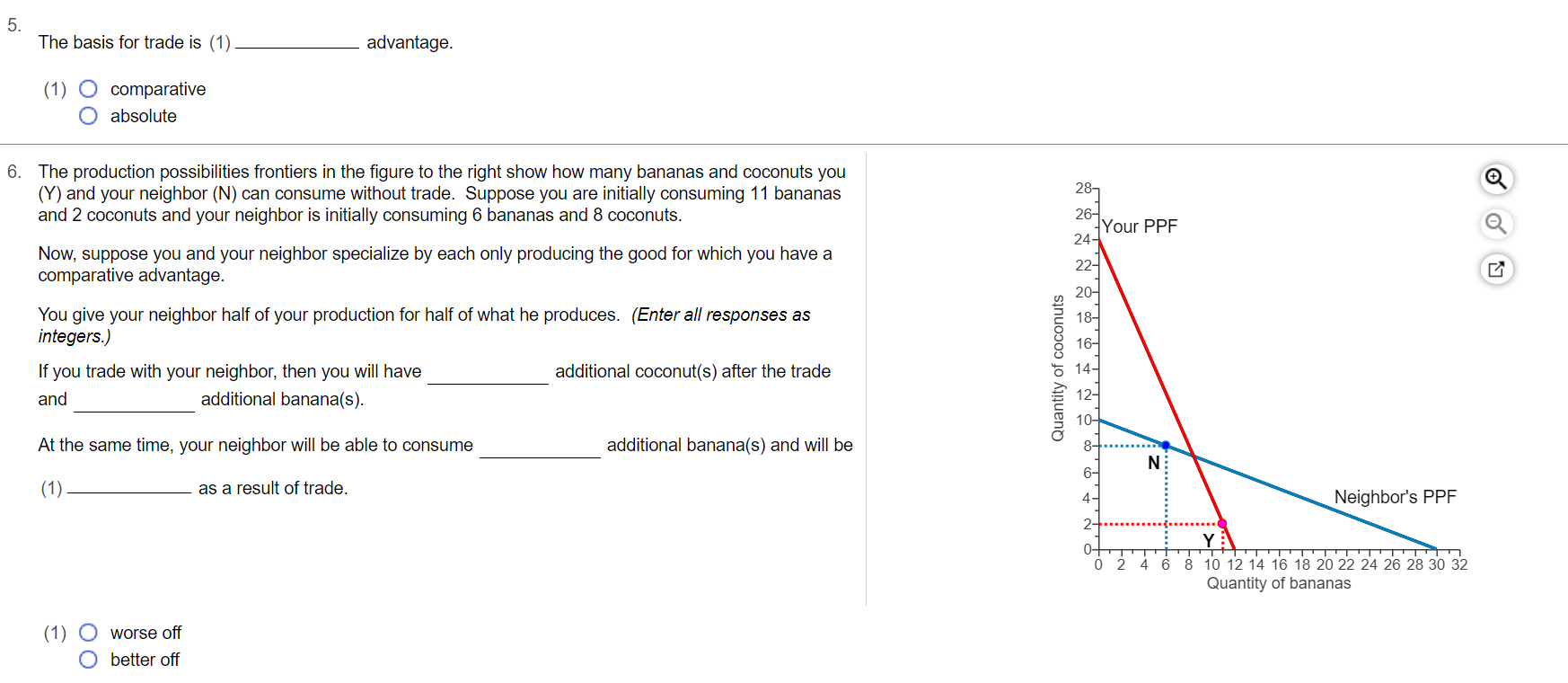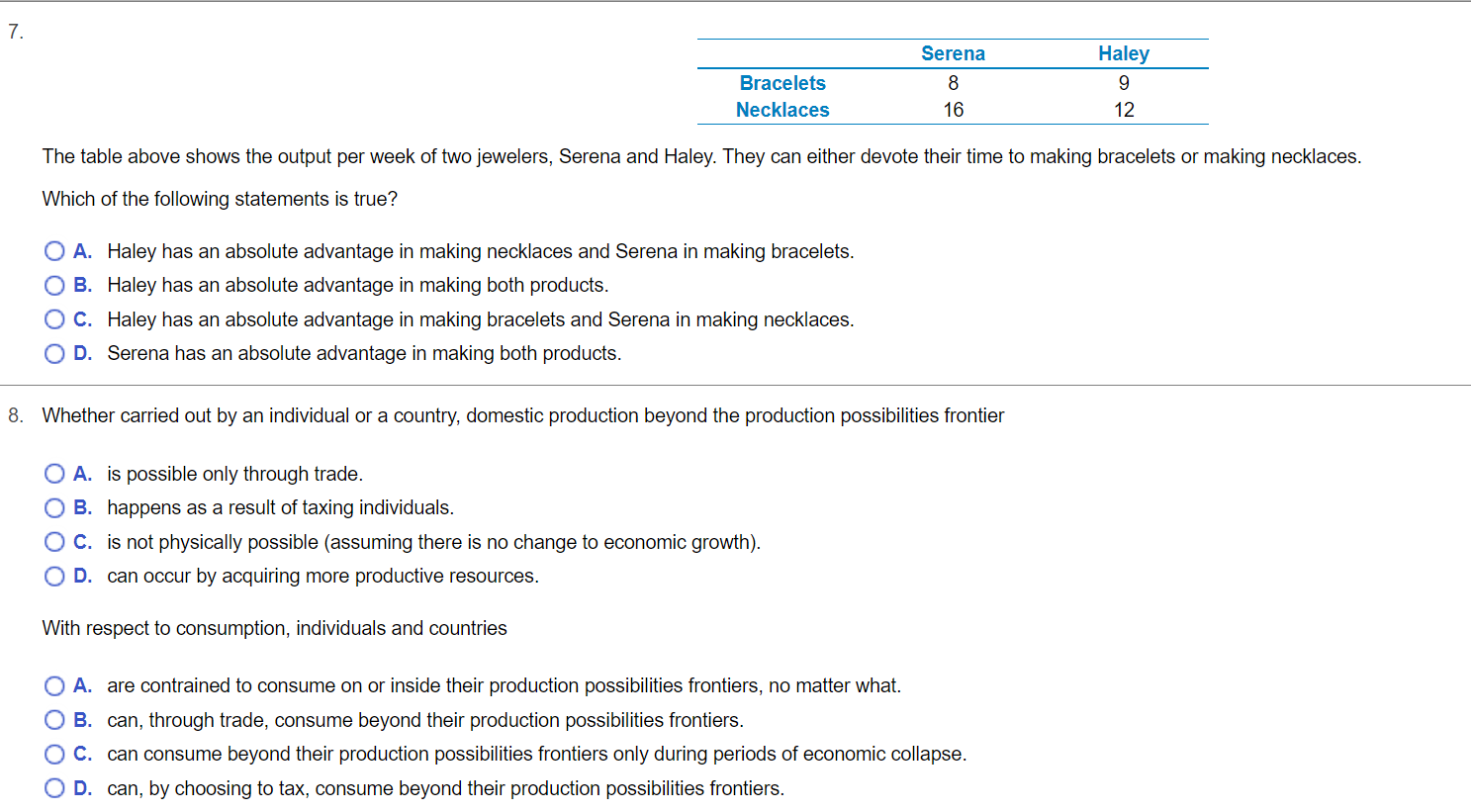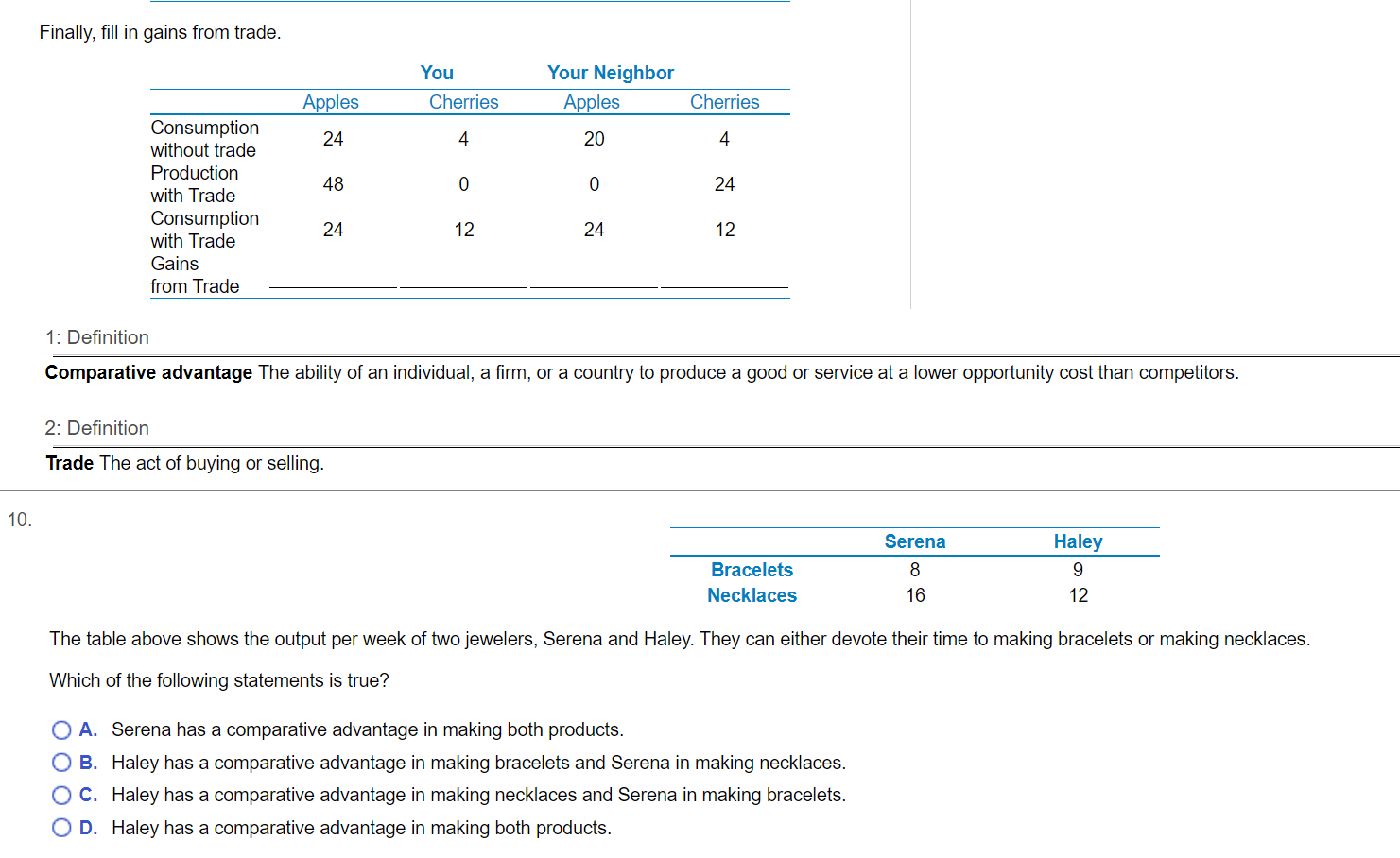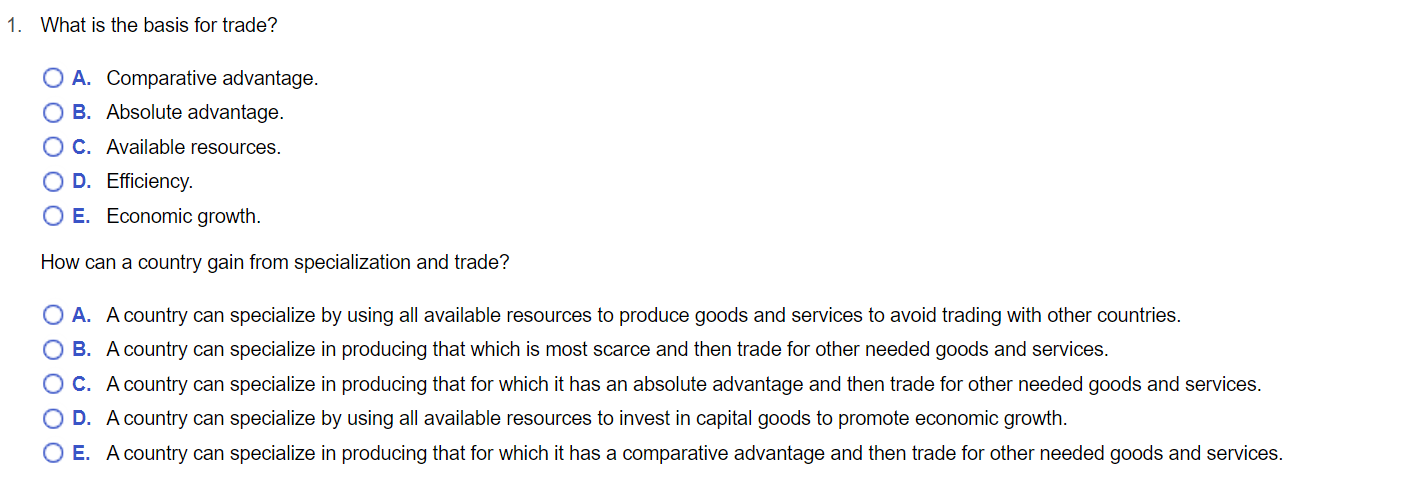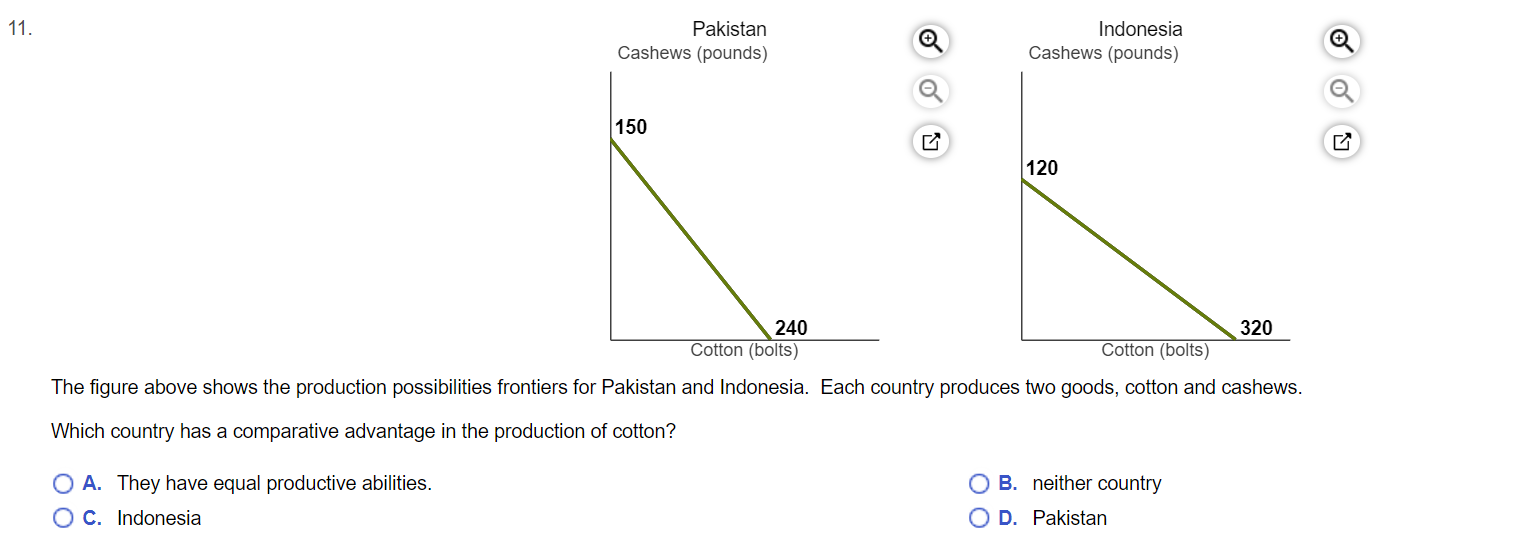
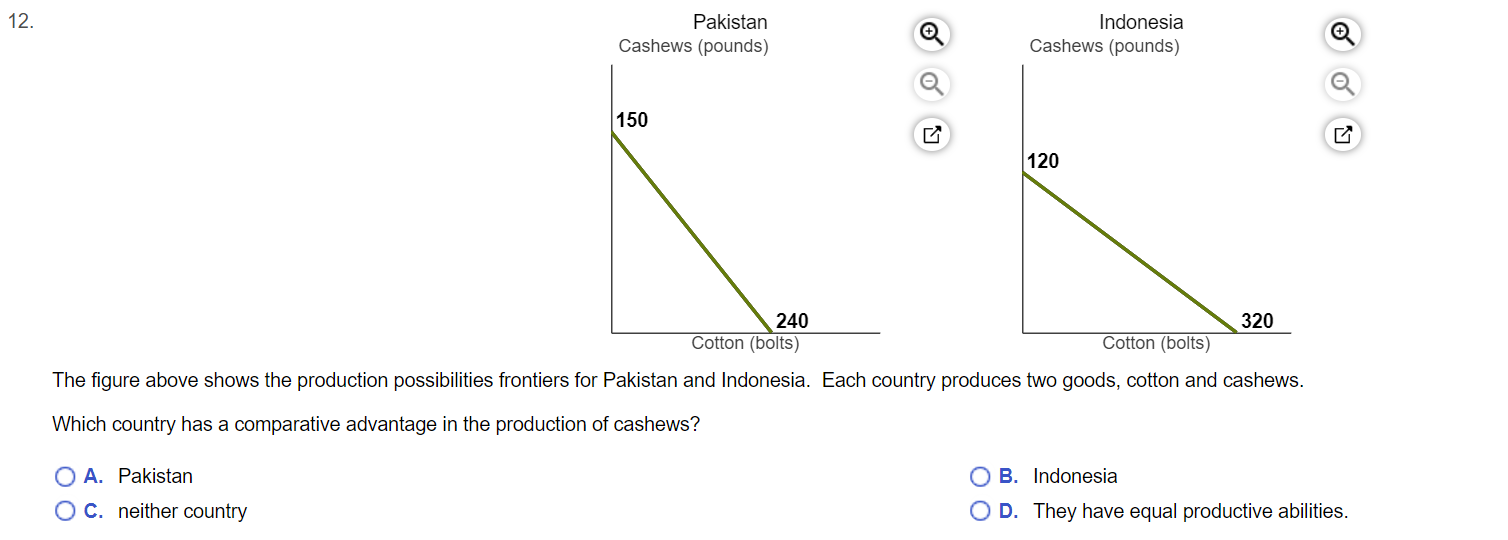


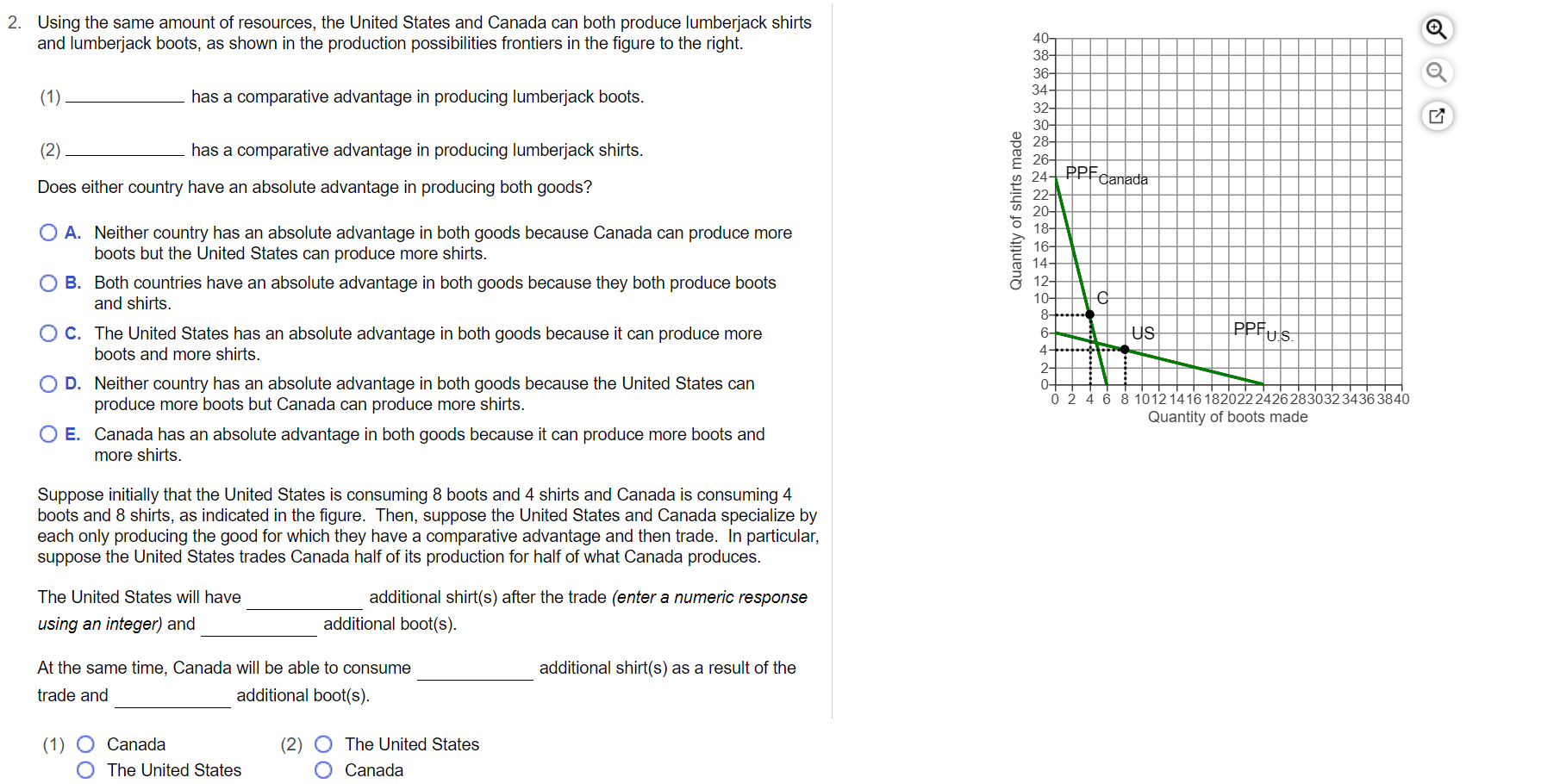

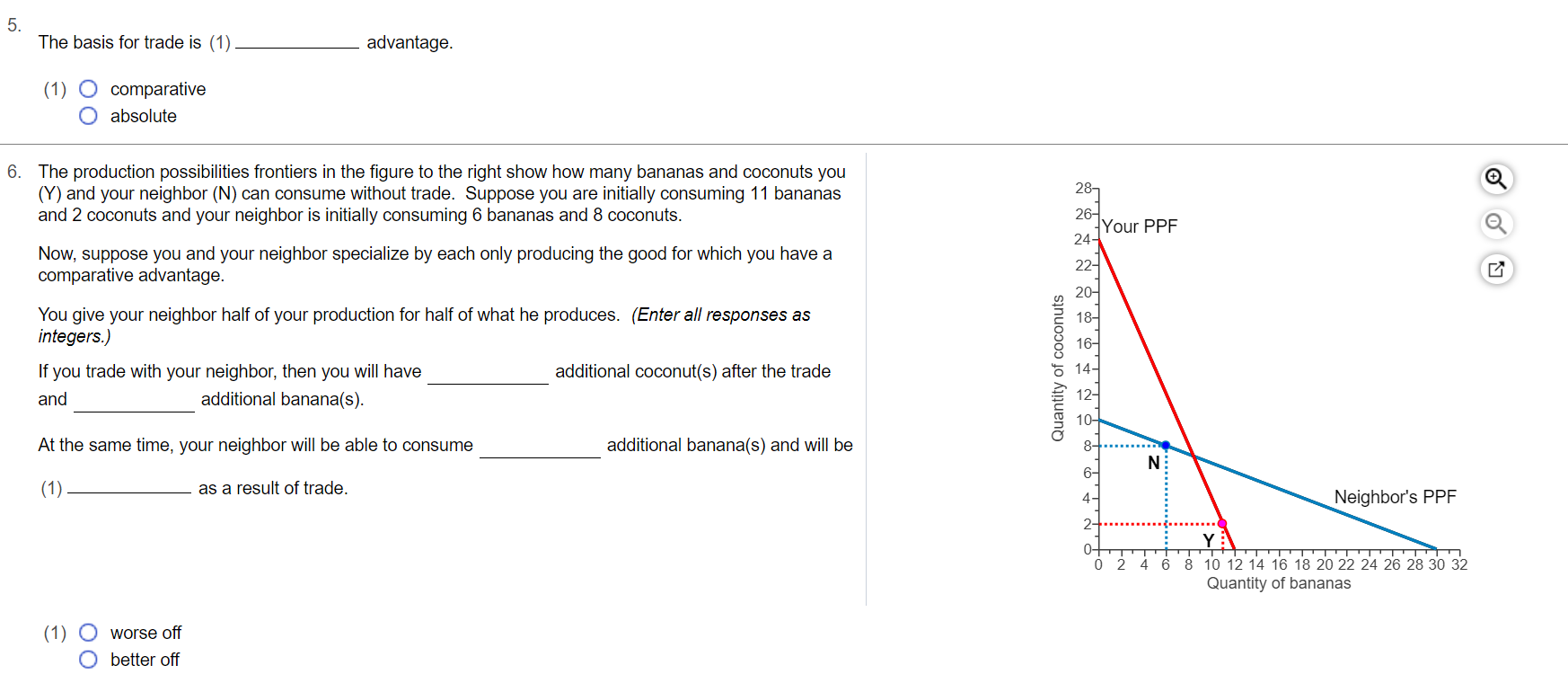
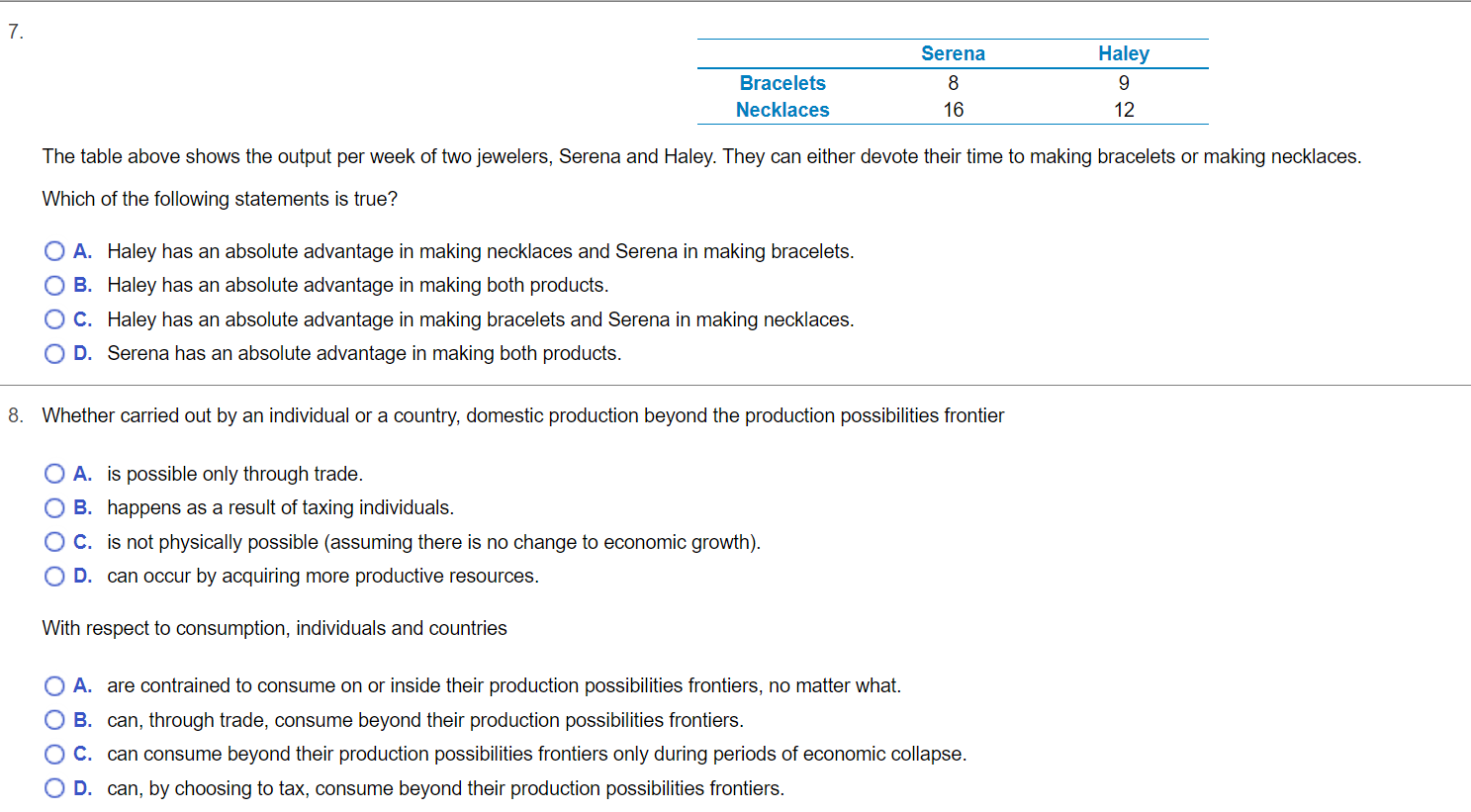
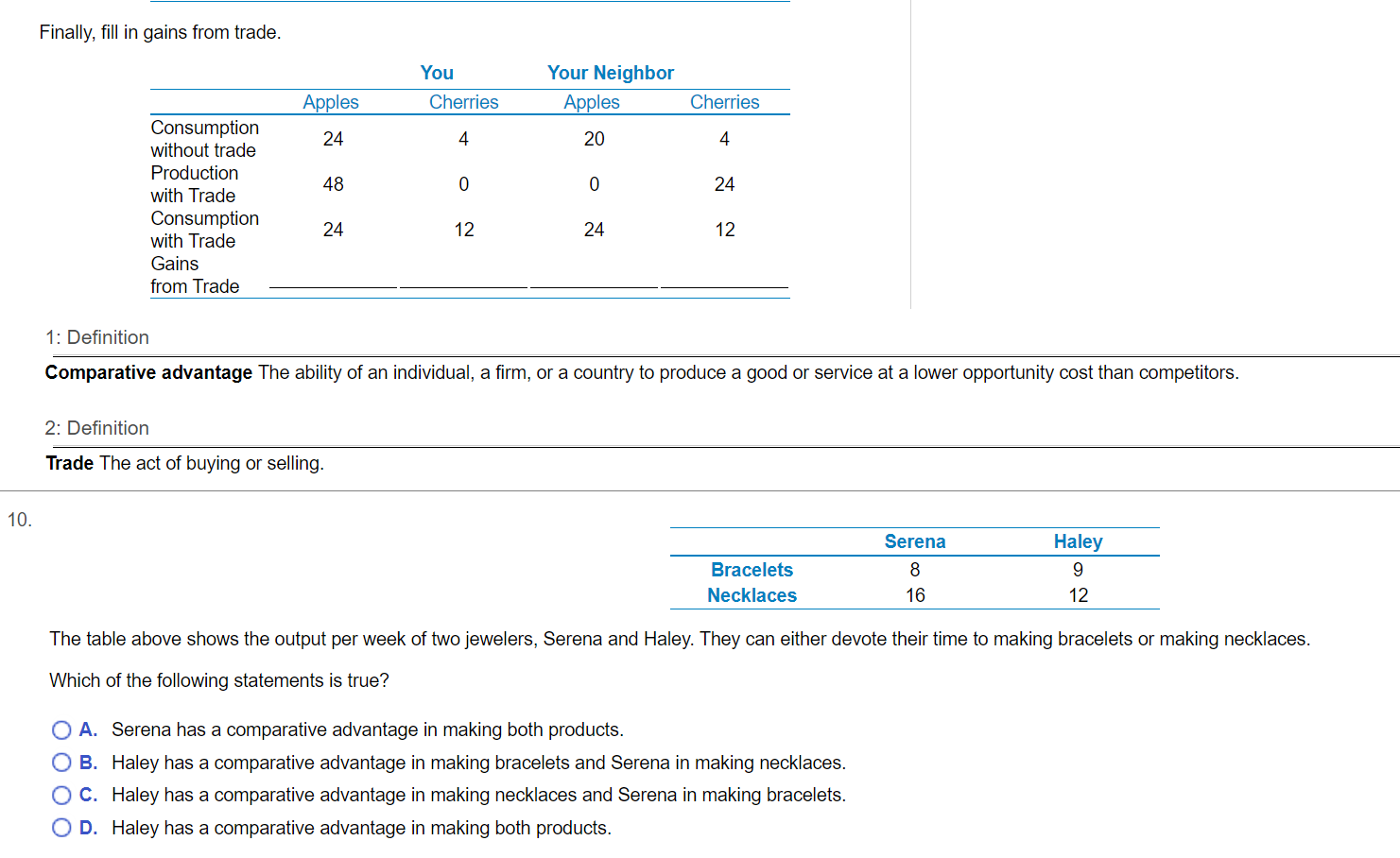
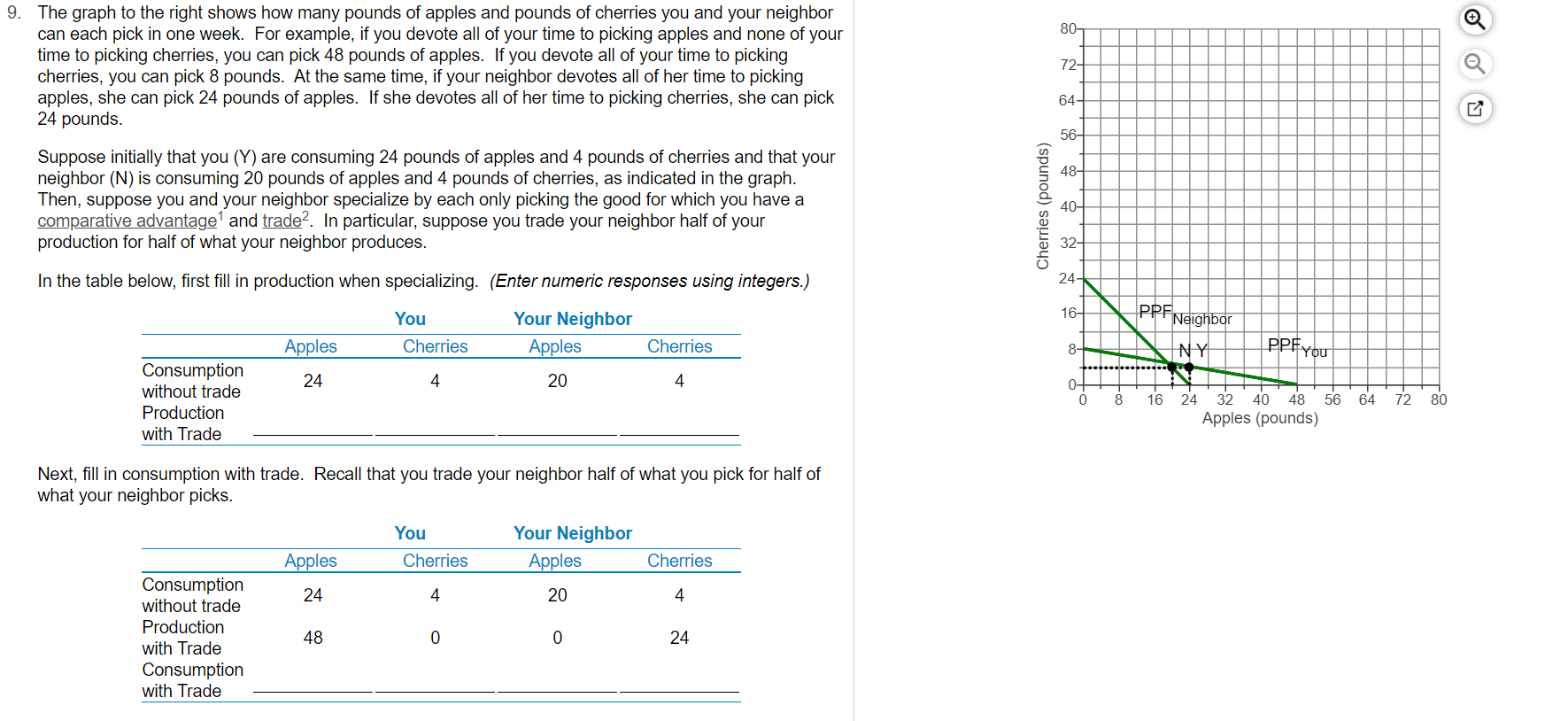
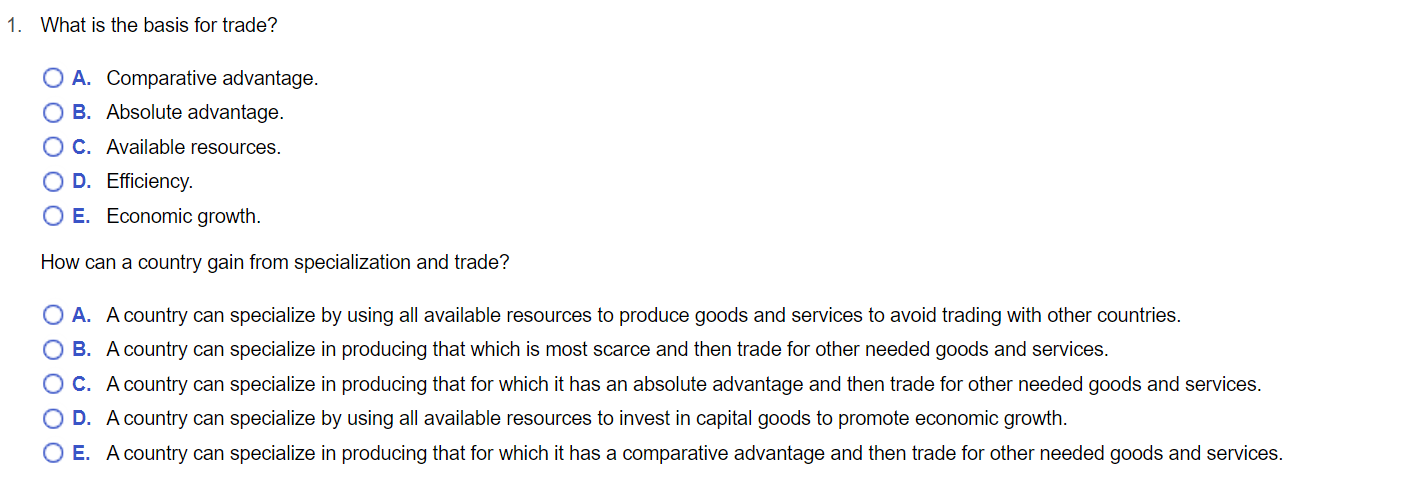
(I only get 1 try to answer)
There should be 15 questions in total and multiple on some of the question like 1,2,3,6,and 9
\f14. (1 ) are goods and services produced domestically but sold to other countries. (2) are goods and services bought domestically but produced in other countries. (3) are taxes imposed by a government on imports of a good into a country. (1) 0 Exports (2) O Tariffs (3) 0 Imports 0 Tariffs O Imports 0 Exports 0 Quotas 0 Exports 0 Quotas 0 Imports 0 Quotas O Tariffs 15. What is the difference between absolute advantage and comparative advantage? (1 ) advantage is the ability of an individual, a rm, or a country to produce a good or service at a lower opportunity cost than competitors. While (2) advantage is the ability of an individual, a rm, or a country to produce more of a good or service than competitors when using the same amount of resources. A countw will always be an exporter of a good where it has (3) advantage in production. (1) 0 Comparative (2) O comparative (3) 0 an absolute 0 Absolute O absolute O acomparative O aoompetitive 2. Using the same amount of resources, the United States and Canada can both produce lumberjack shirts and lumberjack boots, as shown in the production possibilities frontiers in the gure to the right. 38 3. (1) has a comparative advantage in producing lumberjack boots. 3: u 30 (2) has a comparative advantage in producing lumberjack shirts. E :6 Does either country have an absolute advantage in producing both goods? E i: . 2 20 O A. Neither country has an absolute advantage in both goods because Canada can produce more g. 15 boots but the United States can produce more shirts. E :4 O B. Both countries have an absolute advantage in both goods because they both produce boots 3 11 I and shirts. 10 | O C. The United States has an absolute advantage in both goods because it can produce more 3 boots and more shirts. . I O D. Neither country has an absolute advantage in both goods because the United States can produce more boots but Canada can produce more shirts. U 2 4 5 3 1012141_61820222426283032 34363840 Quantity of boots made 0 E. Canada has an absolute advantage in both goods because it can produce more boots and more shirts. Suppose initially that the United States is consuming 8 boots and 4 shirts and Canada is consuming 4 boots and B shirts, as indicated in the gure. Then, suppose the United States and Canada specialize by each only producing the good for which they have a comparative advantage and then trade. In particular, suppose the United States trades Canada half of its production for half of what Canada produces. The United States will have additional shirt(s) after the trade (enters numeric response using an integer) and additional boot(s). At the same time, Canada will be able to consume additional shirt(s) as a result of the trade and additional boot(s). (1) O Canada (2) O The United States O The United States 0 Canada 3. Suppose the United States and Mexico both produce hamburgers and tacos. The combinations of the two goods that each country can produce in one day are presented in the table below. m United States Mexico Hamburgers (in tons) Tacos (in tons) Hamburgers (in tons) Tacos (in tons) 0 72 U 60 40 4B 4 40 BO 24 8 20 120 U 12 O Which country has an absolute advantage in producing tacos? (1) Which country has a comparative advantage in producing tacos? (2) Suppose the United States is currently producing 80 tons of hamburgers and 24 tons of tacos and Mexico is currently producing 8 tons of hamburgers and 20 tons of tacos. If the United States and Mexico each specialize in producing only one good (the good for which each has a comparative advantage), then a total of additional ton(s) of hamburgers can be produced for the two countries combined {enter a numeric response using an integer) and a total of additional ton(s) of tacos can be produced. (1) O The United States (2) 0 Mexico 0 Mexico 0 The United States The basis for trade is ('1) advantage. (1) O comparative O absolute The production possibilities frontiers in the gure to the right show how many bananas and coconuts you (Y) and your neighbor (N) can consume without trade. Suppose you are initially consuming 11 bananas and 2 coconuts and your neighbor is initially consuming 5 bananas and B coconuts. Now, suppose you and your neighbor specialize by each only producing the good for which you have a comparative advantage. You give your neighbor half of your production for half of what he produces. (Enter all responses as integers.) If you trade with your neighbor, then you will have additional oooonut(s) after the trade and additional banana(s). At the same time, your neighbor will be able to consume additional banana(s) and will be (1) as a result oftrade. (1) O worse off 0 betteroff Quantity 01 coconuts % 9,0 Neighbor's PPF 0 2 4 6 3101214161520222426253032 Quantity of bananas Serena Haley Bracelets 8 9 Necklaces 16 12 The table above shows the output per week of two jewelers, Serena and Haley. They can either devote their time to making bracelets or making necklaces. Which of the following statements is true? 0 A. Haley has an absolute advantage in making necklaces and Serena in making bracelets. O B. Haley has an absolute advantage in making both products. 0 C. Haley has an absolute advantage in making bracelets and Serena in making necklaces. O D. Serena has an absolute advantage in making both products. Whether carried out by an individual or a country, domestic production beyond the production possibilities frontier O A. is possible only through trade. 0 B. happens as a result of taxing individuals. 0 C. is not physically possible {assuming there is no change to economic growth). 0 D. can occur by acquiring more productive resources. With respect to consumption, individuals and countries 0 A. are ccntrained to consume on or inside their production possibilities frontiers, no matter what. 0 B. can. through trade, consume beyond their production possibilities frontiers. O C. can consume beyond their production possibilities frontiers only during periods of economic collapse. 0 D. can, by choosing to tax, consume beyond their production possibilities frontiers. Finally, ll in gains from trade. You Your Neighbor Apples Cherries Apples Cherries Consumption without trade 24 4 20 4 Production with Trade 48 O O 24 Consumption with Trade 24 12 24 12 Gains from Trade 1: Definition Comparative advantage The ability of an individual, a rm, or a country to produce a good or service at a lower opportunity cost than competitors. 2: Definition Trade The act of buying or selling. 10. Serena Haley Bracelets 8 9 Necklaces 16 12 The table above shows the output per week of two jewelers, Serena and Haley. They can either devote their time to making bracelets or making necklaces. Which of the following statements is true? 0 A. Serena has a comparative advantage in making both products. 0 B. Haley has a comparative advantage in making bracelets and Serena in making necklaces. O C. Haley has a comparative advantage in making necklaces and Serena in making bracelets. O D. Haley has a comparative advantage in making both products. The graph to the right shows how many pounds of apples and pounds of cherries you and your neighbor can each pick in one week. For example, if you devote all ofyour time to picking apples and none of your time to picking cherries, you can pick 48 pounds of apples. If you devote all of your lime to picking cherries, you can pick 8 pounds. At the same time, if your neighbor devotes all of her time to picking apples, she can pick 24 pounds of apples. If she devotes all of hertime to picking cherries, she can pick 24 pounds. Suppose initially that you (Y) are consuming 24 pounds of apples and 4 pounds of cherries and that your neighbor (N) is consuming 20 pounds of apples and 4 pounds of cherries, as indicated in the graph. Then, suppose you and your neighbor specialize by each only picking the good for which you have a mparative advantage1 and m2. In particular, suppose you trade your neighbor half of your production for half of what your neighbor produces. In the table below, rst ll in production when specializing. (Enter numeric responses using integers.) You Your Neighbor Apples Cherries Apples Cherries Consumption without trade 24 4 20 4 Production with Trade Next, fill in consumption with trade. Recall that you trade your neighbor half of what you pick for half of what your neighbor picks. You Your Neighbor Apples Cherries Apples Cherries Consumption without trade 24 4 2 4 Production with Trade 48 O O 24 Consumption with Trade Cherries (pounds) 80 72 64 Ln 4:. o: ,2. 32 24 0 B 16 24 32 40 4B 56 64 72 80 Apples (pounds) 1. What is the basis for trade? 0 A. Comparative advantage. 0 B. Absolute advantage. 0 C. Available resources. 0 D. Efciency. 0 E. Economic growth. How can a country gain from specialization and trade? 0 A. Acountry can specialize by using all available resources to produce goods and services to avoid trading with other countries. 0 B. Acountry can specialize in producing that which is most scarce and then trade for other needed goods and services. 0 C. Acountry can specialize in producing that for which it has an absolute advantage and then trade for other needed goods and services. 0 D. Acountry can specialize by using all available resources to invest in capital goods to promote economic growth. 0 E. Acountry can specialize in producing that for which it has a comparative advantage and then trade for other needed goods and services











